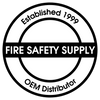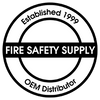Fire Sprinklers Signs
Posted by the FSS Team on Apr 9th 2024
Does your business have all the required NFPA® 13 Sprinkler Systems Signs?
NFPA® 13 (Standard for the Installation of Sprinkler Systems), provides the minimum requirements for the design and installation of automatic fire sprinkler systems and exposure protection sprinkler systems. In its recently released 2022 version, important changes were made. In order to remain compliant with your Sprinkler Systems Signage, it is important you speak with an experienced person.
The purpose of NFPA 13 is to provide a reasonable degree of protection for life and property from fire through standardization of design, installation, and testing requirements for sprinkler systems (including private fire service mains) based on sound engineering principles, test data, and field experience.
Do I need sprinklers in my building?
NFPA 13 is an installation standard and does not specify which buildings or structures require a sprinkler system. NFPA 13 specifies how to properly design and install a sprinkler system using the proper components and materials after it has been determined that a sprinkler system is required. The administrative authority for requiring sprinklers within buildings rests with any of the following: the local building code; NFPA 5000®, Building Construction and Safety Code®; NFPA 101®, Life Safety Code®; International Building Code; or insurance regulations that typically specify which buildings and structures require sprinkler systems. Where the building code does not require a sprinkler system but one is installed voluntarily, the requirements of NFPA 13 still apply to the portion of the building being protected.
If there are no hose racks inside a building that is sprinklered in accordance with NFPA 13, does a hose stream allowance still need to be added to the hydraulic calculations?
Yes. An outside hose stream demand would be required in accordance with Table 11.2.3.1.2 in NFPA 13 (2016 edition). The table specifies an option for 0, 50, or 100 gpm for inside hose demand. Regardless of the inside hose demand, the total combined inside and outside hose demand must meet the flow specified in the table.
Are sprinklers required to be installed above a dropped ceiling?
This is a common question and the answer can be very simple or very complex depending on the nature of the building construction above the ceiling. The simple answer is no, sprinklers are not required if the construction above the ceiling is noncombustible. For buildings where the construction is combustible, sprinklers are required both above and below the ceiling. There are many exceptions to these simple rules that require careful scrutiny and are too lengthy to discuss here. A thorough review of Section 8.15 of NFPA 13 (2016 edition) is necessary to determine if sprinklers are required in specific cases.
How should the distance be measured from a heating source to a sprinkler?
When evaluating the distance from a heating source (such as a diffuser) to a sprinkler, the distance should be measured from the edge of the diffuser to the sprinkler. The proximity of the sprinkler to the heating source will also determine the temperature rating of the sprinkler. See Table 8.3.2.5(a) in NFPA 13 (2016 edition) for specific temperature ratings of sprinklers based on distance from heat sources.
 Since 1999, Fire Safety Supply has been the go-to for fire suppression products, industrial dry chemical systems, high and low-pressure CO2, vehicles, and clean agents. We serve various types of industries such as restaurants, commercial kitchen, wineries, and more.
Since 1999, Fire Safety Supply has been the go-to for fire suppression products, industrial dry chemical systems, high and low-pressure CO2, vehicles, and clean agents. We serve various types of industries such as restaurants, commercial kitchen, wineries, and more.
